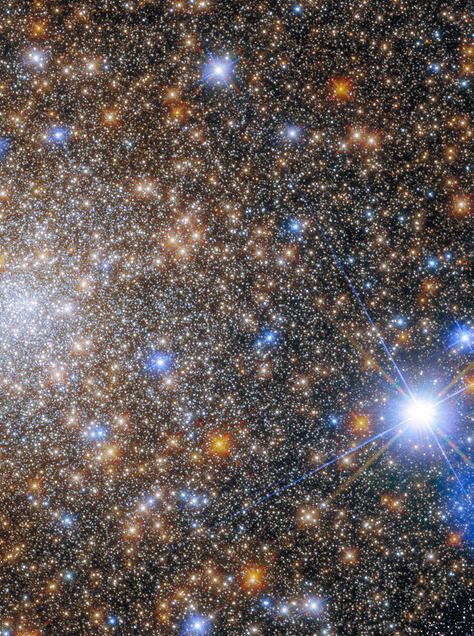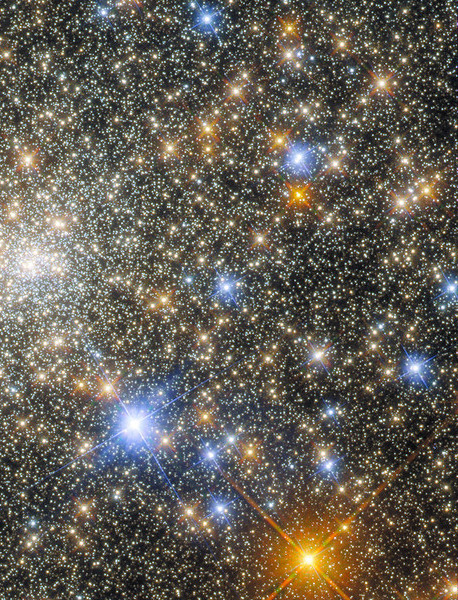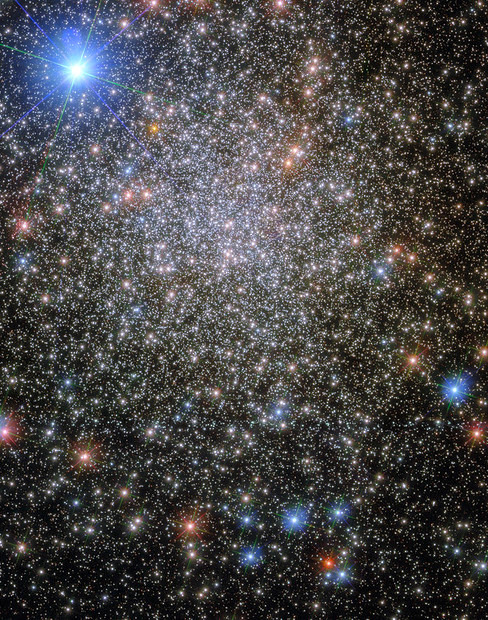The Glittering Globular Cluster Terzan 12 — A Vast, Tightly Bound Collection Of Stars — Fills The

The glittering globular cluster Terzan 12 — a vast, tightly bound collection of stars — fills the frame of this image from the NASA/ESA Hubble Space Telescope. This star-studded stellar census comes from a string of observations that aim to systematically explore globular clusters located towards the centre of our galaxy, such as this one in the constellation Sagittarius. The locations of these globular clusters — deep in the Milky Way galaxy — mean that they are shrouded in gas and dust, which can block or alter the wavelengths of starlight emanating from the clusters.
Here, astronomers were able to sidestep the effect of gas and dust by comparing the new observations made with the razor-sharp vision of Hubble's Advanced Camera for Surveys and Wide-Field Camera 3 with pre-existing images. Their observations should shed light on the relation between age and composition in the Milky Way’s innermost globular clusters.
[Image Description: The frame is completely filled with bright stars, ranging from tiny dots to large, shining stars with prominent spikes. In the lower-right the stars come together in the core of the star cluster, making the brightest and densest area of the image. The background varies from darker and warmer in colour, to brighter and paler where there are more stars.]Credit:
ESA/Hubble & NASA, R. Cohen (Rutgers University)

More Posts from Ad-astra-affecte-spe and Others

M31 Adromeda Galaxy (Visible Light) by NASA Goddard Photo and Video

L1527 IRS - Protostar
Stars form when bodies of dust and gas create enough mass to create a gravitational effect that's able to then pull in more gas, the process continues and the mass increases until the pressure at the centre is sufficient for fusion to begin.
There's many examples of protostars, in fact back in 2012, NASA’s Spitzer Space Telescope focused in on L1527 IRS, believed at the time to be the youngest forming star ever found.

Recently, the JWST re-visited this protostar, and the title image was the result.
The forming star cannot be visually spotted, but is thought to be around 20-40% the mass of our own Sun already.

If you look closely, you can see there's a dark patch in the centre, this is actually the accretion disk around the newly formed star, what is left over after the formation, may go on to form the planets, in fact, they may be actually starting to be created already, as recent evidence does point to planets being born around the same time as the star does in many cases.
The protostar is only 450 light years from Earth in the Constellation of Taurus, and is thought to be around 100,000 years old, a blink of an eye in the life of a star, particularly of this mass.

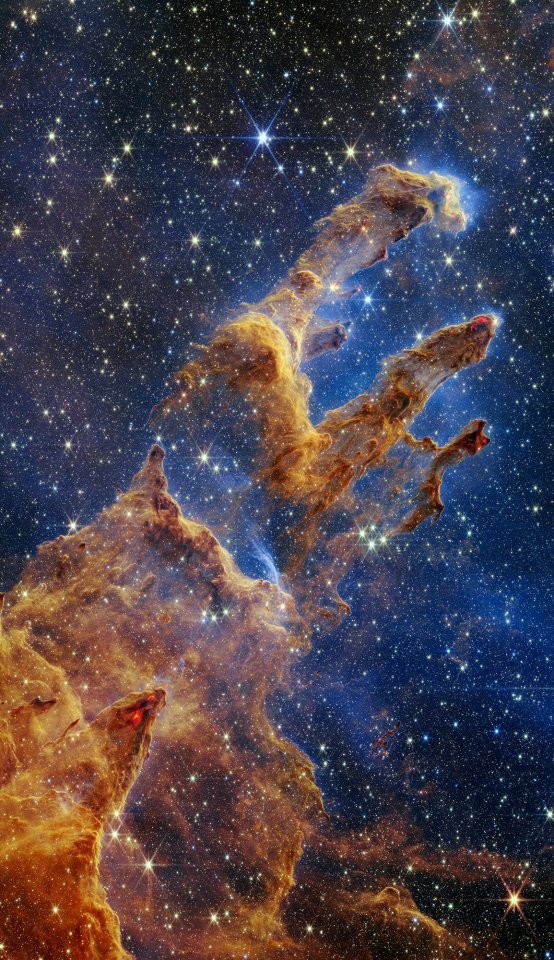
The photos that NASAHubble & NASAWebb took of The Pillars of Creation inspired me deeply. I had to draw what I saw in the formation: A hand reaching into the universe. What an accomplishment for humankind and what a symbol for exploration and knowledge. Credit 2nd image: NASA
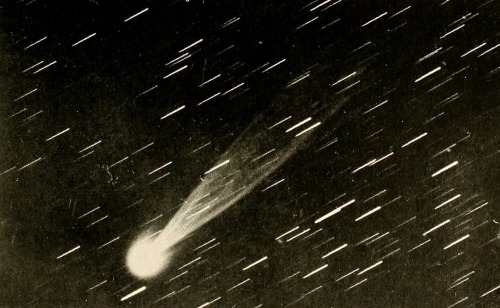



A beginner’s star-book, an easy guide to the stars and to the astronomical uses of the opera-glass, the field-glass and the telescope, 1912

NGC 1365, Heart of the Universe
Y'all, the world is sleeping on what NASA just pulled off with Voyager 1
The probe has been sending gibberish science data back to Earth, and scientists feared it was just the probe finally dying. You know, after working for 50 GODDAMN YEARS and LEAVING THE GODDAMN SOLAR SYSTEM and STILL CHURNING OUT GODDAMN DATA.
So they analyzed the gibberish and realized that in it was a total readout of EVERYTHING ON THE PROBE. Data, the programming, hardware specs and status, everything. They realized that one of the chips was malfunctioning.
So what do you do when your probe is 22 Billion km away and needs a fix? Why, you just REPROGRAM THAT ENTIRE GODDAMN THING. Told it to avoid the bad chip, store the data elsewhere.
Sent the new code on April 18th. Got a response on April 20th - yeah, it's so far away that it took that long just to transmit.
And the probe is working again.
From a programmer's perspective, that may be the most fucking impressive thing I have ever heard.

Earth, which is about 898 million miles (1.44 billion kilometers) away in this image, captured by NASA's Cassini spacecraft 🚀
-
 metaphvsical reblogged this · 1 year ago
metaphvsical reblogged this · 1 year ago -
 violetmoonshine75 liked this · 1 year ago
violetmoonshine75 liked this · 1 year ago -
 clytemnestra7777 reblogged this · 1 year ago
clytemnestra7777 reblogged this · 1 year ago -
 lanemanandcoach liked this · 1 year ago
lanemanandcoach liked this · 1 year ago -
 lattelover57 liked this · 1 year ago
lattelover57 liked this · 1 year ago -
 sparklybasketballpiehuman liked this · 1 year ago
sparklybasketballpiehuman liked this · 1 year ago -
 screaming-velociraptor reblogged this · 1 year ago
screaming-velociraptor reblogged this · 1 year ago -
 screaming-velociraptor liked this · 1 year ago
screaming-velociraptor liked this · 1 year ago -
 tachvintlogic reblogged this · 1 year ago
tachvintlogic reblogged this · 1 year ago -
 error-user-unknown274 reblogged this · 1 year ago
error-user-unknown274 reblogged this · 1 year ago -
 kyrianclawraith liked this · 1 year ago
kyrianclawraith liked this · 1 year ago -
 tachvintlogic reblogged this · 1 year ago
tachvintlogic reblogged this · 1 year ago -
 murderousjelliebean liked this · 1 year ago
murderousjelliebean liked this · 1 year ago -
 tolbachik liked this · 1 year ago
tolbachik liked this · 1 year ago -
 lava-lamp-goo reblogged this · 1 year ago
lava-lamp-goo reblogged this · 1 year ago -
 cluelessbrain liked this · 1 year ago
cluelessbrain liked this · 1 year ago -
 astral-catastrophe reblogged this · 1 year ago
astral-catastrophe reblogged this · 1 year ago -
 astral-catastrophe liked this · 1 year ago
astral-catastrophe liked this · 1 year ago -
 aloneindaastros reblogged this · 1 year ago
aloneindaastros reblogged this · 1 year ago -
 brightestofcentaurus reblogged this · 1 year ago
brightestofcentaurus reblogged this · 1 year ago -
 parasitejasper liked this · 1 year ago
parasitejasper liked this · 1 year ago -
 spacetimewithstuartgary reblogged this · 1 year ago
spacetimewithstuartgary reblogged this · 1 year ago -
 spacetimewithstuartgary liked this · 1 year ago
spacetimewithstuartgary liked this · 1 year ago -
 ad-astra-affecte-spe reblogged this · 1 year ago
ad-astra-affecte-spe reblogged this · 1 year ago -
 manuel82 liked this · 1 year ago
manuel82 liked this · 1 year ago -
 the-yearning-astronaut reblogged this · 1 year ago
the-yearning-astronaut reblogged this · 1 year ago -
 sweden55trc liked this · 1 year ago
sweden55trc liked this · 1 year ago -
 kosyrev liked this · 1 year ago
kosyrev liked this · 1 year ago -
 silvereyedowl liked this · 1 year ago
silvereyedowl liked this · 1 year ago -
 coolspork liked this · 1 year ago
coolspork liked this · 1 year ago -
 andromeda1023 reblogged this · 1 year ago
andromeda1023 reblogged this · 1 year ago

★•Astronomy, Physics, and Aerospace•★ Original and Reblogged Content curated by a NASA Solar System Ambassador
204 posts






